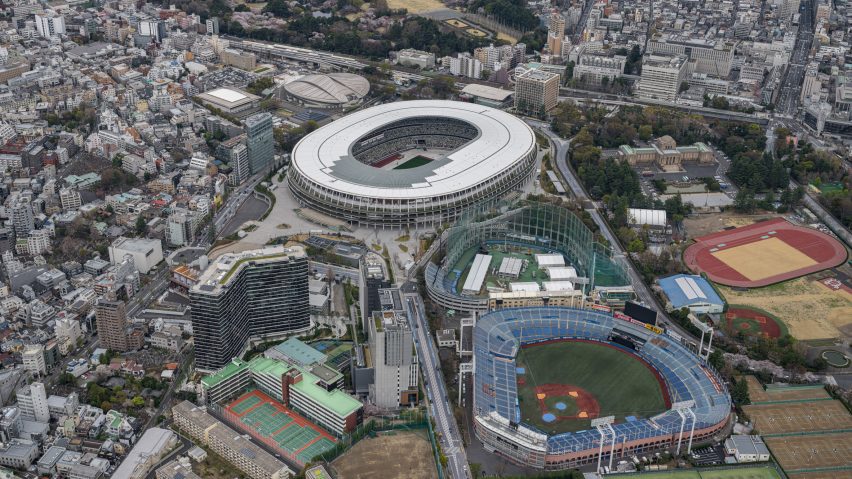This week on Dezeen, we reported on the sustainable aims of the Tokyo 2020 Olympic Games, which were questioned in a peer-reviewed study.
As the Tokyo 2020 Olympic Games kicks off we looked at the initiatives that are aiming to make the games sustainable. These include medals made from old phones, podiums made from recycled plastic and cardboard beds.
However, a report conducted by the University of Lausanne concluded that the games were the third-least sustainable Olympics since 1992.
"The majority of the measures that have been included in this particular Olympics, and the ones that were particularly mediatised, have a more or less superficial effect," David Gogishvili, who is co-author of the report, told Dezeen.
We also rounded up the most architecturally significant venues that will be hosting events during the games, including several buildings designed for the 1964 Olympics in the city.
The centrepiece of the games is the 68,000 capacity Japan National Stadium (picture top) designed by Japanese architect Kengo Kuma, which is one of the few venues built especially for the event.
Our carbon revolution series continued this week with news that Norway has started work on a €1.7 billion project to bury vast amounts of captured carbon under the North Sea.
Eventually, the project could see a total of up to 1.25 billion tonnes of CO2 sequestered in former fossil reserves deep beneath the sea.
A 3D-printed pedestrian bridge designed by Joris Laarman finally opened in Amsterdam this week, six years after the project was first launched.
Spanning the Oudezijds Achterburgwal in Amsterdam's Red Light District, the bridge was made from stainless steel welded by six-axis robotic arms.
In the UK, UNESCO stripped the city of Liverpool of its World Heritage status after it found that a series of recent developments had "eroded the integrity" of the site.
Following a vote that took place in Fuzhou, China, Liverpool joins the Elbe Valley in Germany and the Arabian Oryx Sanctuary in Oman as the only sites to have lost the status.
Also in the UK, the Marble Arch Mound viewpoint in central London was photographed under construction in London.
Designed by Dutch studio MVRDV, the artificial hill rises 25 metres tall alongside Hyde Park and is set to open to the public later this month.
As a spate of supertall skyscrapers – buildings over 300 metres – are under development in New York, we rounded up six that are set to change the city's skyline forever.
In other skyscraper news, Swiss architecture studio Herzog & de Meuron unveiled a 204-metre-tall cylindrical tower in Canary Wharf, London.
Popular projects this week include a gallery for Hauser & Wirth in a collection of historic buildings in Menorca, a hotel in New Orleans in a 19th-century infant asylum and a copper-clad cabin in a Danish forest.
Our lookbooks this week focused on natural biomaterials and office interiors filled with trees and plants.
This week on Dezeen is our regular roundup of the week's top news stories. Subscribe to our newsletters to be sure you don't miss anything.

